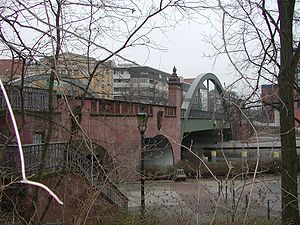Lessing Bridge
Coordinates: 52 ° 31 ′ 22 ″ N , 13 ° 20 ′ 31 ″ E
| Lessing Bridge | ||
|---|---|---|
| Southeast view of the bridge | ||
| use | Road traffic , pedestrians | |
| Crossing of | Spree , oblique | |
| place |
Berlin districts Tiergarten and Moabit |
|
| construction | Tied arch bridge | |
| overall length | 85 m | |
| width | 27 m | |
| Longest span | 52.5 m | |
| Load capacity | more than 240 tons | |
| Headroom | 35 m | |
| Clear height | 5.40 m | |
| vehicles per day | 370 trucks 19,900 vehicles |
|
| start of building | 1982 | |
| completion | 1983 | |
| opening | 1983 | |
| planner | (for the structure): Gregull + Spang Ing.ges.mbh, Berlin |
|
| location | ||
|
|
||
The listed Lessing Bridge crosses the Spree in Berlin . It connects Lessingstrasse in the Hansaviertel in Mitte with Stromstrasse in Moabit .
Emergence
The bridge was built in 1877/1878 by the construction company on the small zoo in connection with the construction of the Hansaviertel as a wooden yoke bridge with a solid superstructure under the name Stromstrasse Bridge , it served as a short connection with today's district of Moabit, which has been inhabited for a long time. In 1897 it was named after the poet Gotthold Ephraim Lessing .
The wooden construction was replaced by a new stone building between 1901 and 1903 according to plans by the city building councilor Ludwig Hoffmann , which stretched across the Spree in several arches. The central opening had a clear width of 29.60 meters, with a passage width of 13 meters and a passage height of 4.30 meters and was therefore suitable for the passage of large Spreek taps. - The bridge was 19 meters wide, with two sidewalks each four meters wide. Red sandstone was used to clad the bridge body .
During the Second World War , the bridge was badly damaged, but not completely destroyed. In 1950, a provisional reconstruction was carried out in the original form, but this meant that the load-bearing capacity was limited to bridge class 30 - that is, a maximum of 30 tons . The bridge was placed under monument protection.
Second new building
Due to the strong increase in the transport of goods by road through the nearby Westhafen and the ever-increasing Spreekähne, a new bridge had to be planned that would allow loads of up to 240 tons and two transport ships to meet under the bridge.
In the early 1980s, the Berlin Senate Department for Urban Development, as the owner, announced a competition that initially envisaged the construction of a contemporary new bridge without supports in the water. However, the submitted designs were not approved by the monument protection authority, so an extensive reconstruction of the old form and style elements was then specified, which was finally achieved by an upwardly guided steel bar arch construction for the central part and the creative replica of the visible surfaces of the side arches and the bridge railings, Pillar structures and stairways was reached. The bronze reliefs with scenes from Lessing's works were recreated by the sculptor August Jäkel in 1983 based on photos. The Berlin company Gregull + Spang, which planned the structure, then carried out the construction and states the following on their website: “The new bridge was assembled on land. Then one end of the bridge was placed on pontoons and pushed over the Spree with walking mechanisms at the other end of the bridge . Truck cranes on the abutments lowered the bridge to the final bearing points. "
On the banks of the Spree, the Berlin Senate had a continuous footpath and cycle path built that crosses under the Lessing Bridge on the Moabit side. The construction phase on the bridge was carried out between 2005 and April 2007 and cost 500,000 euros .
The Lessing Bridge in Art
On the four pillar structures of the first arch bridge there were bronze reliefs with representations of the respective final scenes of four Lessingian dramas ( Miss Sara Sampson , Emilia Galotti , Nathan the Wise and Minna von Barnhelm ) , which were designed by the sculptor Otto Lessing . The reliefs were melted down during World War II. The following gallery shows the replicas from 1983.
- The four bronze reliefs
The bridge has been the subject of visual artists several times. Hans Brass , expressionist and member of the Novembergruppe , created three oil paintings (1919, 1920 and 1952), a linocut (1919) and a chalk drawing (1950). Walter Kohlhoff depicted the bridge in 1978 on a watercolor over a pencil sketch . Heinz Sterzenbach also created a watercolor in 1994 that shows the Lessing Bridge.
literature
- Thiemann, Deszyk, Metzing: Berlin and his bridges , Jaron Verlag, Berlin 2003, pp. 117–118, ISBN 3-89773-073-1
Web links
- Entry in the Berlin State Monument List with further information
- Description of the Lessing Bridge near Luise-Berlin
- The bridges of Moabit - a brief description at berlin: street
Individual evidence
- ↑ Traffic volumes for trucks in 2014 . Road traffic census 2014 as of October 16, 2015 (pdf)
- ↑ Traffic volume map DTV 2014: vehicles in 24 hours
- ^ Sculptor catalog ( Memento from June 23, 2008 in the Internet Archive )
- ↑ Homepage Gregull + Spang
- ↑ Press box of the Berlin Senate Administration .
- ^ Website of the north museums
- ^ Catalog Gallery Sterzenbach






